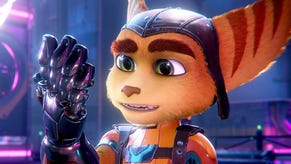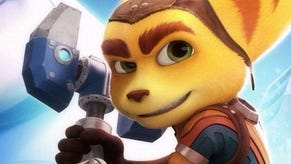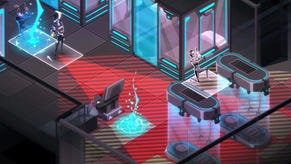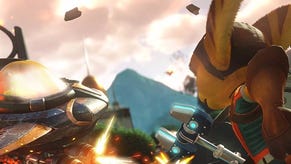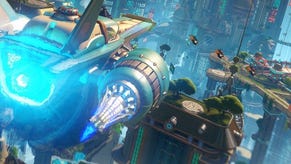Ratchet & Clank
Review - when cranky met clanky, by Kristan
In an industry obsessed with endless sequels and "franchises", it makes a nice change to be greeted with some new characters. Sony recent track record in introducing new "brands" deserves credit, with recent examples such as Jak & Daxter, and the forthcoming The Getaway, Sly Racoon and Primal all looking worthy of any discerning gamer's attention.
So what of Ratchet & Clank, its second double act platformer in a year? Following on from the critical and commercial success of Naughty Dog's lauded Jak & Daxter, we hoped that Insomniac's first non Spyro effort would be in a similar league.
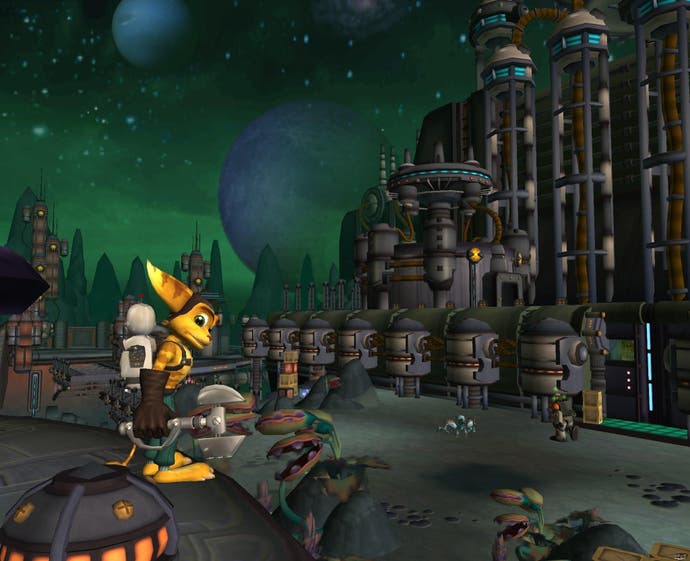
Dastardly
As with any platformer worth its salt, it has the usual good versus evil tale to tell, and guess which side you're on? The evil Chairman Drek is determined to use the best bits of other planets to build a new planet for the inhabitants of his polluted world, Orxon. This, obviously, doesn't sit very well with the rest of the galaxy, and it's up to crack floppy eared mechanic Ratchet and cunning robot Clank to foil his dastardly plans.
Anyone familiar with last year's Jak & Daxter will be immediately at home with Ratchet & Clank. Technically, it's on the same solid ground, being built with Naughty Dog's rather nifty technology that grants the player stunning views of each intricately designed level.
And the control system is practically identical, with movement controlled by the left analogue stick and camera rotation with the right stick, while the four main buttons are used for jump, and weapon select/usage. Meanwhile, the shoulder buttons activate first person view, and crouch, and it's a system that works well for the most part.
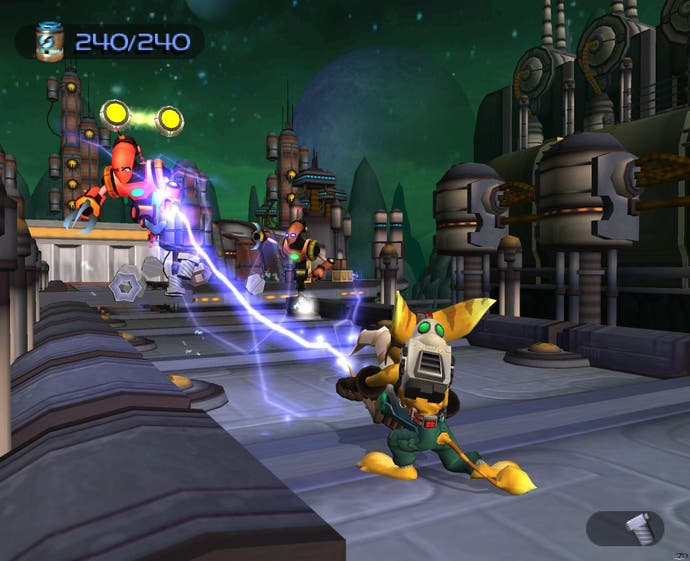
Gratuitous bot gag here
Each level, or planet if you will, presents you with a number of objectives, which basically boil down to having to work through each level destroying progressively tougher enemies, pick up the resulting bolts (which are magnetically attracted to Clank), and eventually reach a particular character who will present you with a crucial object or Infobot with which to travel to your next planet - and hence move on the plot.
Hardly revolutionary stuff, we're sure you're thinking, but where Ratchet & Clank tries to innovate and charm is through the numerous gadgets and weapons that you get to grips with. The aforementioned bolts you gather act as currency, and each planet has its own shop in which you can buy ammo and meatier firepower. But in addition, you also get rewarded with assorted artefacts for your pains, which vary from the humdrum, but effective Blaster to the surreal Taunter - a device that emits comedy noises, and often stupefies enemies to allow for easy despatch.
In fact, each of the 35 gadgets and weapons you gather during the game have their own specific uses, although strictly speaking there are often multiple ways to wipe out your enemies - and progression can be a case of working out which is the most effective weapon. But time is of the essence, and selecting the right gadget or weapon at any one time can seem a bit fiddly to begin with, as it involves hitting triangle, scrolling through the available choices with the D-pad, and selecting the one you want. This, when there are multiple enemies descending upon you, can easily result in death, but it's possible to define a quick select weapon, enabled by double tapping triangle. Even so, in a major battle it's still a muddle trying to juggle which weapon you need, and this should have been managed with more elegance.
Just as well, then, that you're never forced to backtrack too far, as the game intelligently and mercifully saves your progress for you. You still have to wipe out the enemies all over again, but it does at least spare you the task of breaking open boxes again. This approach certainly saves it from being a Blinx-esque joypad smashing horror show, and recognition of your progression, rather than forcing you to start from scratch every time. Such basics make you feel good about playing R&C, and will drive you on towards completing the game, although we reckon most of you will have it cracked in 15 to 20 hours.
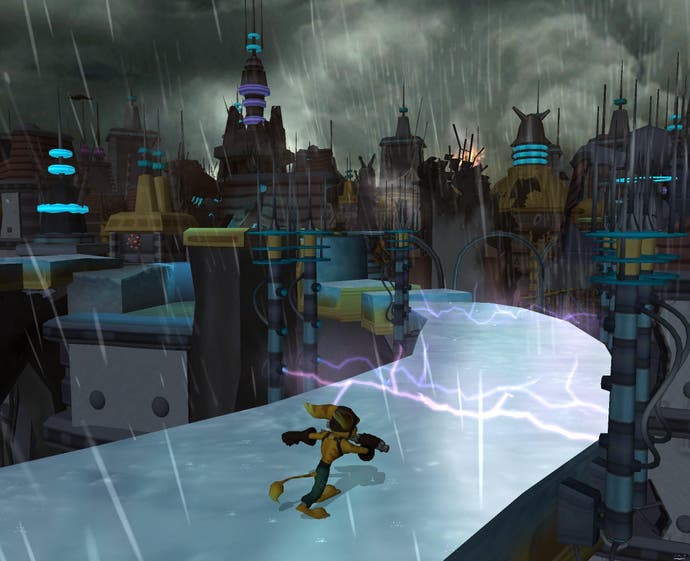
Not just for kids
If you objected to Spyro's kid friendly leanings, you'll be pleasantly surprised to find that R&C has much more of a universal appeal than the cutesy dragon ever did. The game can come across as quirky and comical, and it is, but R&C never descends to irritating slapstick, and instead there it ascends to almost Pixar-esque heights - especially during the many amusing and exceptionally well rendered cut scenes.
Variety is also one of R&C's strengths, and as with its spiritual cousin Jak & Daxter, you get to engage in some welcome diversions such as rail grinding and hoverboard racing. The occasional set piece, such as having to escape from a flooded area, also helps break up the action, as does the appearance of a (predictably gigantic) boss. Somehow these disparate elements all add up to one compelling whole, which drives you on in search of the next section.
Another area Insomniac deserve serious applause is on the visual side. Nearly every planet is stunning, featuring vast views, and incredibly detailed flora and fauna that even moves convincingly when you brush against it. Often you get the chance to ride elevators that sweep you through the level, giving players a chance to really take in the sights. The character modelling is also well up to standard and is not only detailed and well animated, but full of incidental touches that really bring the game to life. R&C pushes the PS2 further than just about any game of its type; it's almost entirely bereft of the dreaded jaggy, and has none of the cardboard cut-out/blocky scenery that blights so many games. However, if there is one criticism it's the slightly muddy colour scheme that sometimes doesn't quite do the artwork justice, but that's just down to personal taste.

Lights! Dodgy camera! Action! Death!
Naturally there are a few areas that make R&C slightly less than perfect. For starters it's saddled with is the same camera problems that blighted J&D. Most of the time it acts intelligently and you'll hardly have to use the right analogue to adjust it. However, when it does choose to be idiotic, it generally waits for the moments that you need it to be on your side - such as during boss encounters where it decides that giving you a good view of the boss is a much better idea than allowing you to see where the hell you're going.
Also, the game lacks the freedom of J&D to roam from one end of the game world to another, being limited instead to a comparatively linear approach where you're forced to wait thirty seconds while you fly between planets. The abandonment of the fantastic "no load" principle makes R&C feel something of a backward step, and as a result makes it feel more like the linear platform games of old rather than the expansive cohesive experience of Naughty Dog's recent epic.
That's not to say we didn't enjoy R&C, because we obviously did. In fact it's hard not to enjoy what is quite easily one of the best platformers on the PS2. It's addictive, tells a good, amusing yarn, looks spectacular and is challenging without ever being annoying. If you're even remotely into run, jump and collect epics, then you have to give R&C a look. It's not our favourite platform game ever, but it's pretty damn close.
Ratchet & Clank screenshots
Ratchet & Clank first impressions


